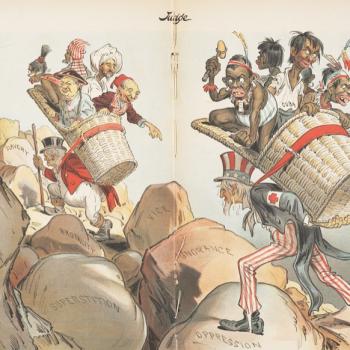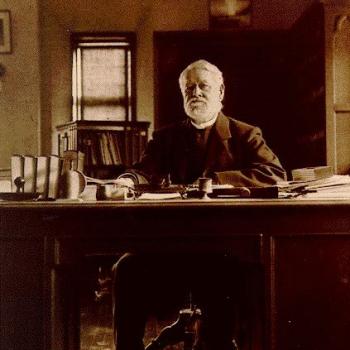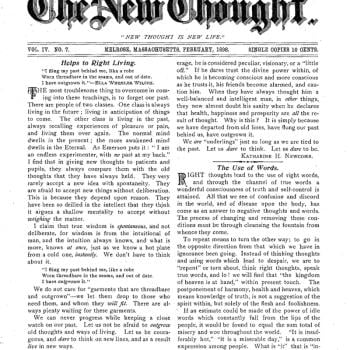I recently posted about the character and drawback of virtual religion, and of what we lose when we are deprived of presence, physicality, and participation. That is a special problem for those of us who are liturgically oriented, and Eucharistic in mindset. How far can liturgical churches survive infinite periods in the Remote and Virtual Wilderness?
Like many others, my own Episcopal parish has included in its Communion service the prayer of St. Alphonsus Liguori, which concerns Spiritual Communion. It reads as follows;
My Jesus,
I believe that You are present in the Most Holy Sacrament.
I love You above all things,
and I desire to receive You into my soul.
Since I cannot at this moment receive You sacramentally,
come at least spiritually into my heart.
I embrace You as if You were already there
and unite myself wholly to You.
Never permit me to be separated from You.
But do note the crucial “as if,” because the believer is not in fact physically present. The best one can hope for is to “come at least spiritually into my heart.” How long can a sacramental church survive on such hopes or promises? Personally, I have long since given up watching streamed services at my own church, despite the best and most creative efforts of our clergy.
With this in mind, let me use here a post I did some years ago about the nature of liturgy, and to see just how much of what I am talking about of necessity involves some kind of physical presence or interaction. That applies to each of the “laws” or principles I cite here, but to some centrally and critically. Note the number of times I talk about the material as set against the spiritual. How far can that apply in a virtual service or ceremony? And also note how much of this depends on being in real time, in front of an actual congregation witnessing the performance, and I make no apology for using the word performance in this context. For me at least, the points made here help me understand just what is lacking in any virtual service.
My fundamental point is that liturgy matters. It is a vast topic, which is the subject of very wide-ranging scholarship. Here, though, let me just suggest briefly why it is so central to church life.
Throughout Christian history, a majority of Christians have used a liturgy in the sense of a set form of words, actions and rituals, as opposed to a free-form, open-ended kind of worship. This does not mean non-liturgical churches are totally disorganized — they often plan their services according to familiar patterns and models. But they do not follow the precise sequence of texts, passages or actions, which they regard as too formal and constricting. Still today, though, liturgical churches overwhelmingly represent the Christian norm. Once we take account of Catholics, Orthodox, Anglicans and Lutherans, that would probably represent three quarters of all Christians worldwide. Recently too, even historically non-liturgical churches have selectively adopted liturgical forms, in what some call an “ancient futures” movement.
In its origins, the Greek word leitourgia meant “people’s work,” better translated as something like “public service” or “public duty.” In common usage, the word also refers to the liturgy, namely the particular service that culminates in the Eucharist or Holy Communion. A Catholic or Anglican liturgy includes various parts that together form a logical sequence and a unified whole, like a symphony. These include, for instance, such set-pieces as the Kyrie Eleison, the Gloria, the Creed, the Sanctus and the Agnus Dei (Lamb of God).
So what does liturgy do, and why does it still exert its astonishing appeal after two millennia? Without any attempt to be definitive, let me offer my nine laws of liturgy:
1.Liturgy takes us out and puts us in
Liturgy takes us out of the regular world and returns us to a sacred moment or sacred time. It is a way of putting us in touch with a particular reality, of converging and conforming our world with the supernatural. Liturgy thus explains why we are here but at the same time also places us somewhere else.
Paths cross here.
2.Liturgy unites, making many one
The liturgy organizes and moves people through a common sense of participation, of shared action. It unites us and makes us a common body. We say and do things in the same way, we speak the same words and hear the same things and express agreement to them. It is communal action. To use the Anglican phrase, we all share in common (i.e., communal) prayer.
3.That unity crosses boundaries of time and space
The fact that liturgy is fixed means that anywhere you go in the world, you will hear the same words and the same patterns. Services are not “dealer’s choice” in which any words or forms are permissible, and they don’t depend on the whims of particular leaders. That is also why we use the formal language appropriate to solemn things. Historic form and language are used to consecrate time.
When we share in a liturgy today, we are doing essentially the same thing that countless others were doing a hundred or a thousand years ago. Liturgy thus creates community and continuity with past and present, proclaiming a link with past and future. We see this, for example, when we repeat ancient Greek terms like Kyrie Eleison. Language speaks us.
4.Liturgy uses action to declare and reinforce common belief
The old phrase says lex orandi,lex credendi, “the law of prayer is the law of belief” — roughly, show me how you worship and I’ll know what you believe. Not just in its verbal statements, a Eucharist proclaims the Church’s basic teachings through what the participants say and do. Every moment, it teaches the idea of incarnation.
5.Liturgy tells stories in ways that make us live them
People make sense of the world through storytelling, which allow us to build and shape memory. We tell stories in different ways, sometimes through words but also through action. Ritual and behavior are singularly effective ways of telling a story. A liturgy like the Christian Eucharist also tells a story in order to preserve and pass on the church’s memory.
6.Liturgy uses performance to tell stories
Without embarrassment, I use the theatrical word “performance.” As in any theatrical performance, liturgy uses cues to move to different phases — some moments and events signify beginnings and endings, calling you to be onstage. Like any play too there are ups and downs, an ascent to a climax and then a return to something like normal. In a Eucharist particularly, we share different actions and experiences appropriate to different phases of the event. And there are clearly distinct portions, different “acts.”
7.Liturgy unites and binds things that otherwise are wholly separate
Liturgy is sacramental, in that it uses many different kinds of material symbol and object to carry spiritual truths. It also unites the mind and the bodily senses. It is not just rational and book-centered. It uses physical beauty as a means of presenting and reinforcing truth. Readings and texts are integrated into the larger “performance,” with its changing moods and lessons.
8.Liturgy consecrates time — or else time consecrates liturgy
Stories and performances all have their appropriate times and settings. Liturgical actions, likewise, depend wholly on the cycles of the church year. Participating in liturgy means we share in this cycle, we join its beginnings and share the route to its end. Much of this journey involves non-literate means, including seasonally appropriate colors and lights.
Finally, and shockingly:
9.Liturgy allows earth to become heaven, however briefly
The Bible repeatedly describes liturgical actions, on Earth and in heaven, at God’s court. We see this especially in books like Isaiah and Revelation. In turn, those scriptural passages have had a huge impact on the actual practice and language of earthly churches. In a prayer like the Sanctus, the “Holy,” humans celebrate with angels, breaking down divisions between natural and supernatural, Earth and heaven. That is the central theme of the Eucharist.
And those are my nine laws of liturgy. Another person might have three or 300, and they would probably be just as valid.
I fear that the whole model depends on those crucial themes I outlined last time, of presence, participation, and in short, being there.













